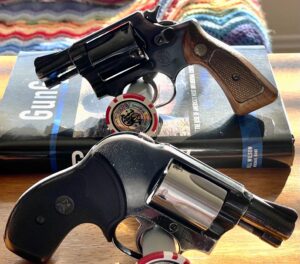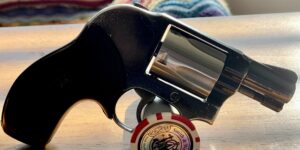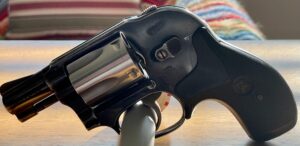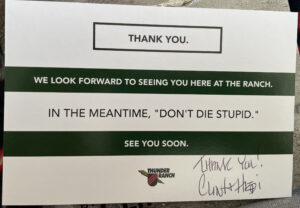This is going out to Bones. You asked, we provide. We’re running a full service blog here.

Back strap of the gun showing wear. Also that is a hammer and you can cock it for single-action fire: the hammer is just protected by a shroud.

My J-frames. Let me show them to you. Top gun is a Model 36 (no dash). You can’t tell from the photo but it has an Apex trigger kit installed.
As best as I’ve been able to determine, this was shipped in March 1974, and has the pinned barrel and stainless steel cylinder. Per the Standard Catalog, the ones with the stainless steel cylinder went to Michigan Police Supply, but I can’t confirm that without sending off for a factory letter. (I do plan to do that, but I’ve got other guns in the shipping letter queue ahead of this one.)
This is not an awesome gun, to be honest. It has a lot of bluing wear, and isn’t that great looking. But: it was $250 (plus tax) out the door from my local gun shop. Try finding anything these days for $250: even the Ruger LCPs are going for more than that. I think the gunsmith at Sportsman’s also may have done some work on the trigger for this one, just based on some comments he made to me.
This is also super light. (15.75 ounces unloaded. For comparison, the Model 36 pictured above weighs in at 19.75 ounces, also unloaded.) If I’m wearing something with large enough pockets, I can easily slip this into one. The shrouded hammer makes it so you don’t really need a holster: however, I’d use one anyway. (I have a pocket holster for my other J-frame that will work with this one. I’m sort of halfway looking for an IWB holster, because I don’t always wear pants with large pockets, and I think an IWB holster allows faster draws than a pocket one.)
I’ve bought some Hornady Critical Defense in 90 and 110-grain (not +P). Once I get out to the range and see how that shoots, I’ll probably use that as my defense load. It gets decent performance in the LuckyGunner tests.
=====
I’ve read or skimmed a fair number of books by company founders. There’s sort of a formula to them: how I got the idea for my business, built it up while overcoming obstacles along the way, and what I see in the future for my company. Many of the ones I’ve looked into remind me of…
Bill Wilson’s book, Gun Guy (available from Wilson Combat: this is not an affiliate link) is not completely immune to Macho Business Donkey Wrestling. But it does have a lot going for it:
- It is a gun book.
- Mr. Wilson has an interesting story.
- There’s actually a lot of useful information in it.
Great and good friend of the blog (and official trainer to WCD) Karl Rehn did his own review of this book a while back. This is intended to be supplemental to his review.
Gun Guy doesn’t stint on the photos. There are a lot of them, including many photos of WC custom guns. One issue I had, though, is that I can’t find credits for many of them. I know a lot of the photos are from the Wilson family collection, but it feels like the gun photos (especially the ones at the back of the book) were taken specifically for the book, and I’d like to know who did it.
A second issue I have is that the book could have used another proofreading pass. There are spots in the text that are kind of rough, either because bits were dropped or because of jarring punctuation issues. If there’s ever a second printing, I’ll volunteer to do a proof-reading pass over the text before it goes back to print.
Offsetting these (frankly, relatively minor) issues is the usefulness of the book. There’s an entire chapter (with photos) showing how to lubricate your 1911, Beretta 92, or AR. There’s another chapter devoted to useful shooting drills (including the Bill Drill) that I think is a good starting point for new shooters. (I’d recommend supplementing that with John Daub’s Drills, Qualifications, Standards and Tests.)
As for the business stuff, Wilson’s story of starting and growing the business is interesting. Especially since the formation and growth of Wilson Combat is intimately tied to the history of practical pistol shooting, particularly the early days of IPSC, USPSA, and IDPA which Mr. Wilson covers in some detail.
In terms of actually running a custom shop, though…I think there’s some good information on dealing with customers and understanding your market here. With all due respect to Mr. Wilson’s considerable skills, though, I get the feeling that Wilson Combat’s success is due, in part, to Mr. Wilson being in the right place at the right time – those early days of practical pistol shooting I mentioned above – in addition to his talent.
Could someone build a business like Wilson Combat in the current environment? I don’t know. In addition to regulatory and practical issues, it seems like Wilson Combat was a market maker. Before, there were very few shops doing what they did, and those shops were backlogged for months or years. Mr. Wilson saw a gap and filled it, which is swell. Wilson Combat’s shown the way for hundreds of other custom shops. How many slots are left?
Should you read Gun Guy? My answer is a fairly enthusiastic “yes”, for the practical information about maintenance, the shooting tips, the excellent photography, and (if that’s your cup of tea) the historical information on the early days of practical shooting. If you’re looking for a practical guide to starting and running your own custom gun business, I still recommend it, but not as enthusiastically. I’m not sure there is a book I’d recommend if that’s what you want to do.
For $20 at the show, Gun Guy was a bargain.
(Do I own any Wilson Combat guns? Sort of. It’s complicated. I own a Beretta 92 that has had some work done on it by WC, but is not an actual WC gun. I should do a post on that gun at some point. I’m hatching a plan, once I get my year-end bonus, to send another gun off to WC for new sights and a conversion to .38 Super.)
=====
I ordered a book the other day from Thunder Ranch. (Urban Rifle 2. I already have Urban Rifle, and UR2 appears to be sole source from TR.)
I ordered it on Thursday. It arrived on Monday. And this was tucked inside:
Nice touch.



Well done. The Model 638 was my EDC until I picked up a SIG P365 SAS. I like that you have the Pachmayr stocks on it, I find them to be better than the Hogues for grip. The Hogues seem to move in my hand more.
Nice gun.
Wow. I didn’t expect the 38 series to have such personal resonance.
For the record, the Pachmayr’s were on the gun when I bought it. I am tempted to pick up a proper set of factory J-frame stocks (maybe when I’m at the symposium next week) but only to have around. For everyday carry, I think the Pachmyer’s are probably a better choice.
(I have to say, though: Hogue does get some props from me. That was a really nice gun mat they were handing out at the NRA show.)
If you don’t mind me asking, what did you use for reloads on the 638? I have both Safariland speedloaders and load strips for the Model 36, which should work on the 38 as well. But you can never have too many loading options….
I have carried both. The Bianchi speed strip, and the HKS speedloader. The HKS makes a visible bulge in my right pocket, so when in shorts the speed strip. The HKS is, (obviously), much faster.
I used the HKS on the 638 that I got for my issued backups. (Models 60, 642 and 640 in .357.) Sometimes I carried two in the pocket.
I have Pachmayr’s on all the guns that will take them, and that I can find them for. They’re the right amount of grippy, without having a box grater next to your skin. I managed to find on Gun Broker Pachmayr stocks for my 3″ 686, which provide a hammer shroud, like the 638 does. It’s a nice snag-free option.